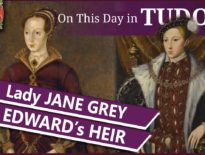On this day in Tudor history, 20th June 1540, Henry VIII’s fourth wife, Queen Anne of Cleves, complained to her advisor about her husband’s interest in one of her maids of honour, a certain Catherine Howard. What was going on and what happened next?
Find out more about the final weeks of Henry VIII's and Anne of Cleves' marriage in today's talk.
Also on this day in Tudor history, 20th June 1567, a silver casket of eight letters, which have become known as the Casket Letters, were allegedly found in the possession of James Hepburn, Earl of Bothwell, the third husband of Mary, Queen of Scots. Find out more about these letters in last year’s video:
xxxx
Also on this day in history:
- 1560 – Death of Francis Hastings, 2nd Earl of Huntingdon, at Ashby-de-la-Zouch. Francis was married to Katherine Pole, daughter of Henry Pole, Baron Montagu, but was fortunate to survive the fall of the Poles in 1538. His son, Henry, was educated with Henry VIII's son, the future Edward VI, who made Hastings a member of his Privy Council in 1550. Hastings and his son were imprisoned in the Tower by Mary I for their support of Lady Jane Grey in 1553, but were pardoned a few months later. He served Edward VI, Mary I and Elizabeth I as Lord Lieutenant of Leicestershire.
- 1565 – Margaret Douglas sent to the Tower of London by Elizabeth I after the announcement of the betrothal of Mary, Queen of Scots and Lord Darnley, Margaret's son. She was released after Darnley's murder in February 1567.
- 1568 – Death of Armagil Waad (Wade), Chief Clerk of the Privy Council and member of Parliament during Edward VI's reign, at Belsize Park, Hampstead. He was buried in Hampstead Church. Waad lost his office and his seat in Parliament in Mary I's reign.
- 1584 – Hanging of Dermot O'Hurley, Catholic Archbishop of Carshel and martyr, at Hoggen's Green, just outside Dublin. He had been linked with the Roman Inquisition and was tortured by having his feet put in tin boots and then put in front of a fire. He was beatified 27th September 1992.
- 1585 – Death of Henry Percy, 8th Earl of Northumberland, on the night of the 20th/21st June in the Tower of London. Northumberland had, allegedly, shot himself through the heart, although it was rumoured that he was murdered by Sir Christopher Hatton on the orders of Elizabeth I's government. Northumberland had been imprisoned in the Tower in January 1584 for his Catholic beliefs and his involvement in plots to do with Mary, Queen of Scots. He was laid to rest in the chapel of St Peter ad Vincula at the Tower.
- 1595 – Burning of Walter Marsh, spy and Protestant martyr, in Rome's Campo dei Fiori. Before he was burned, he had his hands and tongue cut off. He had been accused of spying on Catholics for Elizabeth I, and of committing offences against Catholics.
Transcript:
On this day in Tudor history, 20th June 1540, Queen Anne of Cleves, Henry VIII’s fourth wife, complained to her advisor, Carl Harst, the Cleves ambassador, about her husband’s interest in one of her maids of honour, a certain Catherine Howard.
Harst tried to reassure the worried queen that it was just a “light romance” and that Anne and the king would soon be off on their summer progress, but Harst had actually known of the king’s interest in Catherine for months.
There were also rumours going around about the king wanting to divorce Anne. London merchant Richard Hilles recorded what he’d heard about the king, Anne and Catherine Howard in a letter to Heinrich Bullinger:
“Before St. John Baptist’s day [24th June] it was whispered the King intended to divorce his queen Anne, sister of the duke of Gelderland, whom he had married publicly at Epiphany after last Christmas. Courtiers first observed that he was much taken with another young lady, very small of stature, whom he now has, and whom he was seen crossing the Thames to visit, often in the day time and sometimes at night. The bishop. of Winchester provided feastings for them in his palace, but it was looked upon as a sign of adultery, not of divorce.”
On 22nd June, Harst was able to report that Anne was much happier, which historian Retha Warnicke puts down to Catherine Howard having left court. However, the queen’s happiness was to be very shortlived. On 24th June 1540, Anne reported to Harst that she was being sent away from court to Richmond Palace and that she’d be leaving the next day. It was said that she was being sent there to avoid the Plague and that the king would join her, but there was no plague and she never saw the king again as his wife.
On 7th July 1540, a convocation of clergy agreed that “the king and Anne of Cleves were no wise bound by the marriage solemnised between them”, and messengers were then sent to Anne to get her agreement to the annulment of the marriage. Anne must have been upset, for she believed herself to be the true queen, but she also feared what would happen if she resisted the king’s request. Anne wrote to the king confirming that she accepted the annulment and signing herself “Anne, the daughter of Cleves”, rather than “Anne, the Queen”. Henry must have been delighted and relieved with her submission, and he wrote back to her, addressing her as his “right dear and right entirely beloved sister”, thanking her and informing her that he was intending to endow her with £4000 per year and houses at Richmond and “Blechinglegh” (Bletchingley).
Anne was rewarded handsomely for her acceptance of the situation, also receiving jewels, plate, hangings, furniture, a house in Lewes and the lease of Hever Castle, the former Boleyn family home.
On 9th July 1540, Anne’s marriage to Henry VIII was declared null “by reason of a precontract between lady Anne and the marquis of Lorraine, that it was unwillingly entered into and never consummated, and that the King is at liberty to marry another woman, and likewise the lady Anne free to marry”. Less than three weeks after that, on 28th July 1540 Henry VIII married Catherine Howard.
Of course, Catherine fell in 1541, when it was found that she hadn’t been a virgin when she married the king and that she’d been having secret meetings at night with Thomas Culpeper. Anne hoped that the king would return to her, but he didn’t, and in 1543 he married his sixth and final wife, Catherine Parr. Anne may have been unhappy with the end of her marriage, but she kept her head and also kept good relationships with the king and her stepchildren. Anne outlived the king and his other wives, dying in July 1557 at the age of 41.



Leave a Reply